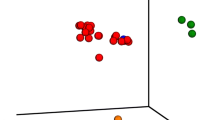Abstract
The sapropelic ciliate Plagiopyla nasuta was isolated and cultured in monoculture. Optimal conditions for growth were: 15–20°C, pH about 7, and about 2% of oxygen in the headspace. Cultures of P. nasuta produced methane. Epifluorescence microscopy revealed the presence of methanogenic bacteria as endosymbionts. An endosymbiont of the ciliate was isolated and identified as Methanobacterium formicicum. In the ciliate cell these methanogens were found to be closely associated with microbody-like organelles. No mitochondria could be detected.
Similar content being viewed by others
References
Balch WE, Fox GE, Magrum LJ, Woese CR, Wolfe RS (1979) Methanogens: Reevaluation of a unique biological group. Microbiol Rev 43:260–296
Ball GH (1969) Organisms living on and in protozoa. In: Chen TT (ed) Research in protozoology, vol 3. Pergamon Press, New York, pp 565–718
Bick H (1972) Ciliated protozoa. World Health Organization, Geneva
Doddema HJ, Vogels GD (1978) Improved identification of methanogenic bacteria by fluorescence microscopy. Appl Environ Microbiol 36:752–754
Eirich LD, Vogels GD, Wolfe RS (1978) Proposed structure for coenzyme F420 from Methanobacterium. Biochem 17:4583–4593
Fenchel T, Perry T, Thane A (1977) Anaerobiosis and symbiosis with bacteria in free-living ciliates. J Protozool 24:154–163
Finlay BJ, Laybourn J, Strachan I (1979) A technique for the enumeration of benthic ciliated protozoa. Oecologia 39:375–377
Gorris LGM, Van der Drift C (1986) Methanogenic cofactors in pure cultures of methanogens in relation to substrate utilization. In: Dubourguier HC, Albagnac G, Montreuil J, Romond C, Sautière P, Guillaume J (eds) Biology of anaerobic bacteria. Progress in biotechnology, vol 2. Elsevier Science Publishers, Amsterdam, pp 144–150
Gould-Veley LJ (1905) A further contribution to the study of Pelomyxa palustris (Greeff). J Linn Soc 29:374–395
Hutten TJ, De Jong MH, Peeters BPH, Van der Drift C, Vogels GD (1981) Coenzyme M (2-mercaptoethanesulfonic acid)-derivates and their effects on methane formation from carbon dioxide and methanol by cell-free extracts of Methanosarcina barkeri. J Bacteriol 145:27–34
Jankowski AW (1964) Morphology and evolution of ciliophora III. Arch Protistenk 107:185–294
Kahl A (1930–1935) Wimpertiere oder Ciliata (Infusoria). In: Dahl F (ed) Die Tierwelt Deutschlands, part 18, 21, 25 and 30. Fischer, Jena
Kiener A, Leisinger T (1983) Oxygen sensitivity of methanogenic bacteria. System Appl Microbiol 4:305–312
Lee JJ, Soldo AT, Reisser W, Lee MJ, Jeon KW, Görtz H-D (1985) The extent of algal and bacterial endosymbioses in protozoa. J Protozool 32:391–403
Liebmann H (1937) Bakterienzymbiose bei Faulschlammziliaten. Biol Zbl 57:442–445
Marmur J (1961) A procedure for the isolation of deoxyribonucleic acid from microorganisms. J Mol Biol 3:208–218
Miller TL, Wolin MJ (1974) A serum bottle modification of the Hungate technique for cultivating obligate anaerobes. Appl Microbiol 27:985–987
Van Bruggen JJA, Stumm CK, Vogels GD (1983) Symbiosis of methanogenic bacteria and sapropelic protozoa. Arch Microbiol 136:89–95
Van Bruggen JJA, Zwart KB, Van Assema RM, Stumm CK, Vogels GD (1984) Methanobacterium formicicum, an endosymbiont of the anaerobic ciliate Metopus striatus McMurrich. Arch Microbiol 139:1–7
Van Bruggen JJA, Stumm CK, Zwart KB, Vogels GD (1985) Endosymbiotic methanogenic bacteria of the sapropelic amoeba Mastigella. FEMS Microbiol Ecol 31:187–192
Van Bruggen JJA (1986) Methanogenic bacteria as endosymbionts of sapropelic protozoa. Ph. D. Thesis, University of Nijmegen, The Netherlands
Van Bruggen JJA, Zwart KB, Hermans JGF, Van Hove EM, Stumm CK, Vogels GD (1986) Isolation and characterization of Methanoplanus endosymbiosus sp. nov., an endosymbiont of the marine sapropelic ciliate Metopus contortus. Arch Microbiol 144:367–374
Van Bruggen JJA, Van Rens GLM, Geertman EJM, Zwart KB, Stumm CK, Vogels GD (1988) Isolation of a methanogenic endosymbiont of the sapropelic amoeba Pelomyxa palustris Greeff. J Protozool 35:20–23
Author information
Authors and Affiliations
Rights and permissions
About this article
Cite this article
Goosen, N.K., Horemans, A.M.C., Hillebrand, S.J.W. et al. Cultivation of the sapropelic ciliate Plagiopyla nasuta Stein and isolation of the endosymbiont Methanobacterium formicicum . Arch. Microbiol. 150, 165–170 (1988). https://doi.org/10.1007/BF00425157
Received:
Accepted:
Issue Date:
DOI: https://doi.org/10.1007/BF00425157




